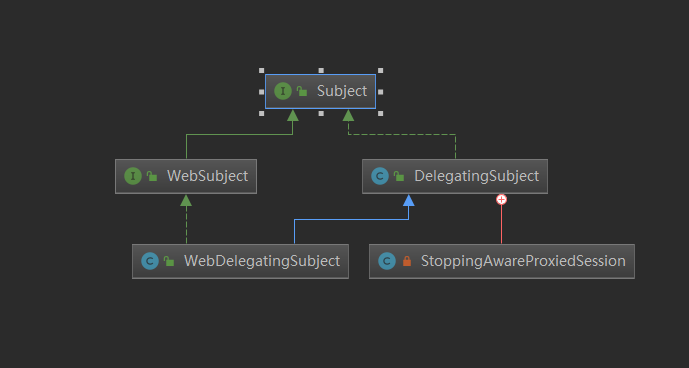我们在平常使用Shrio进行身份认证时,经常通过获取Subject 对象中保存的Session、Principal等信息,来获取认证用户的信息,也就是说Shiro会把认证后的用户信息保存在Subject 中供程序使用
public static Subject getSubject() { return SecurityUtils.getSubject(); }
Subject 是Shiro中核心的也是我们经常用到的一个对象,那么Subject 对象是怎么构造创建,并如何存储绑定供程序调用的,下面我们就对其流程进行一下探究,首先是Subject 接口本身的继承与实现,这里我们需要特别关注下WebDelegatingSubject这个实现类,这个就是最终返回的具体实现类

在Shiro中每个http请求都会经过SpringShiroFilter的父类AbstractShiroFilte中的doFilterInternal方法,我们看下具体代码
protected void doFilterInternal(ServletRequest servletRequest, ServletResponse servletResponse, final FilterChain chain) throws ServletException, IOException { Throwable t = null; try { final ServletRequest request = prepareServletRequest(servletRequest, servletResponse, chain); final ServletResponse response = prepareServletResponse(request, servletResponse, chain); //创建Subject final Subject subject = createSubject(request, response); //执行Subject绑定 //noinspection unchecked subject.execute(new Callable() { public Object call() throws Exception { updateSessionLastAccessTime(request, response); executeChain(request, response, chain); return null; } }); } catch (ExecutionException ex) { t = ex.getCause(); } catch (Throwable throwable) { t = throwable; } if (t != null) { if (t instanceof ServletException) { throw (ServletException) t; } if (t instanceof IOException) { throw (IOException) t; } //otherwise it‘s not one of the two exceptions expected by the filter method signature - wrap it in one: String msg = "Filtered request failed."; throw new ServletException(msg, t); } }
继续进入createSubject方法,也就是创建Subject对象的入口
protected WebSubject createSubject(ServletRequest request, ServletResponse response) { return new WebSubject.Builder(getSecurityManager(), request, response).buildWebSubject(); }
这里使用了build的对象构建模式,进入WebSubject接口中查看Builder与buildWebSubject()的具体实现
Builder()中主要用于初始化SecurityManager 、ServletRequest 、ServletResponse 等对象,构建SubjectContext上下文关系对象
*/
public Builder(SecurityManager securityManager, ServletRequest request, ServletResponse response) {
super(securityManager);
if (request == null) {
throw new IllegalArgumentException("ServletRequest argument cannot be null.");
}
if (response == null) {
throw new IllegalArgumentException("ServletResponse argument cannot be null.");
}
setRequest(request);
setResponse(response);
}
buildWebSubject方法中开始构造Subject对象
public WebSubject buildWebSubject() { Subject subject = super.buildSubject();//父类build方法 if (!(subject instanceof WebSubject)) { String msg = "Subject implementation returned from the SecurityManager was not a " + WebSubject.class.getName() + " implementation. Please ensure a Web-enabled SecurityManager " + "has been configured and made available to this builder."; throw new IllegalStateException(msg); } return (WebSubject) subject; }
进入父类的buildSubject对象我们可以看到,具体实现是由SecurityManager来完成的
public Subject buildSubject() { return this.securityManager.createSubject(this.subjectContext); }
在createSubject方法中会根据你的配置从缓存、redis、数据库中获取Session、Principals等信息,并创建Subject对象
public Subject createSubject(SubjectContext subjectContext) { //create a copy so we don‘t modify the argument‘s backing map: SubjectContext context = copy(subjectContext); //复制一个SubjectContext对象 //ensure that the context has a SecurityManager instance, and if not, add one: context = ensureSecurityManager(context); // 检查并初始化SecurityManager对象 //Resolve an associated Session (usually based on a referenced session ID), and place it in the context before //sending to the SubjectFactory. The SubjectFactory should not need to know how to acquire sessions as the //process is often environment specific - better to shield the SF from these details: context = resolveSession(context);//解析获取Sesssion信息 //Similarly, the SubjectFactory should not require any concept of RememberMe - translate that here first //if possible before handing off to the SubjectFactory: context = resolvePrincipals(context);//解析获取resolvePrincipals信息 Subject subject = doCreateSubject(context);//创建Subject //save this subject for future reference if necessary: //(this is needed here in case rememberMe principals were resolved and they need to be stored in the //session, so we don‘t constantly rehydrate the rememberMe PrincipalCollection on every operation). //Added in 1.2: save(subject); return subject; }
在doCreateSubject中通过SubjectFactory创建合成Subject对象
protected Subject doCreateSubject(SubjectContext context) { return getSubjectFactory().createSubject(context); }
我们可以看到最后返回的是具体实现类WebDelegatingSubject
public Subject createSubject(SubjectContext context) { //SHIRO-646 //Check if the existing subject is NOT a WebSubject. If it isn‘t, then call super.createSubject instead. //Creating a WebSubject from a non-web Subject will cause the ServletRequest and ServletResponse to be null, which wil fail when creating a session. boolean isNotBasedOnWebSubject = context.getSubject() != null && !(context.getSubject() instanceof WebSubject); if (!(context instanceof WebSubjectContext) || isNotBasedOnWebSubject) { return super.createSubject(context); } //获取上下文对象中的信息 WebSubjectContext wsc = (WebSubjectContext) context; SecurityManager securityManager = wsc.resolveSecurityManager(); Session session = wsc.resolveSession(); boolean sessionEnabled = wsc.isSessionCreationEnabled(); PrincipalCollection principals = wsc.resolvePrincipals(); boolean authenticated = wsc.resolveAuthenticated(); String host = wsc.resolveHost(); ServletRequest request = wsc.resolveServletRequest(); ServletResponse response = wsc.resolveServletResponse(); //构造返回WebDelegatingSubject对象 return new WebDelegatingSubject(principals, authenticated, host, session, sessionEnabled, request, response, securityManager); }
以上是Subject的创建过程,创建完成后我们还需要与当前请求线程进行绑定,这样才能通过SecurityUtils.getSubject()方法获取到Subject
Subject对象本质上是与请求所属的线程进行绑定,Shiro底层定义了一个ThreadContext对象,一个基于ThreadLocal的上下文管理容器,里面定义了一个InheritableThreadLocalMap<Map<Object, Object>>(),Subject最后就是被放到这个map当中,我们获取时也是从这个map中获取
首先我们看下绑定操作的入口,execuse是执行绑定,后续操作采用回调机制来实现
//执行Subject绑定 //noinspection unchecked subject.execute(new Callable() { public Object call() throws Exception { updateSessionLastAccessTime(request, response); executeChain(request, response, chain); return null; } });
初始化一个SubjectCallable对象,并把回调方法传进去
public <V> V execute(Callable<V> callable) throws ExecutionException { Callable<V> associated = associateWith(callable);//初始化一个SubjectCallable对象,并把回调方法传进去 try { return associated.call(); } catch (Throwable t) { throw new ExecutionException(t); } } public <V> Callable<V> associateWith(Callable<V> callable) { return new SubjectCallable<V>(this, callable); }
看下SubjectCallable类的具体实现
public class SubjectCallable<V> implements Callable<V> { protected final ThreadState threadState; private final Callable<V> callable; public SubjectCallable(Subject subject, Callable<V> delegate) { this(new SubjectThreadState(subject), delegate);//初始化构造方法 } protected SubjectCallable(ThreadState threadState, Callable<V> delegate) { if (threadState == null) { throw new IllegalArgumentException("ThreadState argument cannot be null."); } this.threadState = threadState;//SubjectThreadState对象 if (delegate == null) { throw new IllegalArgumentException("Callable delegate instance cannot be null."); } this.callable = delegate;//回调对象 } public V call() throws Exception { try { threadState.bind();//执行绑定操作 return doCall(this.callable);//执行回调操作 } finally { threadState.restore(); } } protected V doCall(Callable<V> target) throws Exception { return target.call(); } }
具体绑定的操作是通过threadState.bind()来实现的
public void bind() { SecurityManager securityManager = this.securityManager; if ( securityManager == null ) { //try just in case the constructor didn‘t find one at the time: securityManager = ThreadContext.getSecurityManager(); } this.originalResources = ThreadContext.getResources(); ThreadContext.remove();//首先执行remove操作 ThreadContext.bind(this.subject);//执行绑定操作 if (securityManager != null) { ThreadContext.bind(securityManager); } }
在上面bind方法中又会执行ThreadContext的bind方法,这里就是之前说到的shiro底层维护了的一个ThreadContext对象,一个基于ThreadLocal的上下文管理容器,bind操作本质上就是把创建的Subject对象维护到resources 这个InheritableThreadLocalMap中, SecurityUtils.getSubject()方法其实就是从InheritableThreadLocalMap中获取所属线程对应的Subject
private static final ThreadLocal<Map<Object, Object>> resources = new InheritableThreadLocalMap<Map<Object, Object>>();//定义一个InheritableThreadLocalMap public static void bind(Subject subject) { if (subject != null) { put(SUBJECT_KEY, subject);//向InheritableThreadLocalMap中放入Subject对象 } } public static void put(Object key, Object value) { if (key == null) { throw new IllegalArgumentException("key cannot be null"); } if (value == null) { remove(key); return; } ensureResourcesInitialized(); resources.get().put(key, value); if (log.isTraceEnabled()) { String msg = "Bound value of type [" + value.getClass().getName() + "] for key [" + key + "] to thread " + "[" + Thread.currentThread().getName() + "]"; log.trace(msg); } }
三、总结
从以上对Shiro源码的分析,我们对Subject对象的创建与绑定进行了基本的梳理,Subject对象的创建是通过不断的对context上下文对象进行赋值与完善,并最终构造返回WebDelegatingSubject对象的过程;Subject对象创建后,会通过Shiro底层维护的一个基于ThreadLocal的上下文管理容器,即ThreadContext这个类,与请求所属的线程进行绑定,供后续访问使用。对Subject对象创建与绑定流程的分析,有助于理解Shiro底层的实现机制与方法,加深对Shiro的认识,从而在项目中能够正确使用。希望本文对大家能有所帮助,其中如有不足与不正确的地方还望指出与海涵。
原文:https://www.cnblogs.com/dafanjoy/p/14343168.html